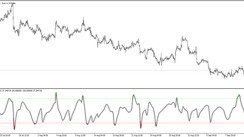While day trading, the concept of risk management becomes paramount. Trailing stop-loss orders can be a crucial tool for traders, facilitating risk minimization or locking in potential profits by dynamically adjusting with favorable market movements. The choice to use a trailing stop-loss isn't a necessity, but more of an individual preference. Familiarizing yourself with the basic framework of trailing stop-loss orders can empower you to decide if this risk-management method suits your trading style.
The Essence of Trailing Stop-Loss Orders
Primarily designed to control trade risks, a stop-loss order is an automatic counteractive directive that exits a trader from a deal with a market order if the asset price moves against their expectations, hitting the pre-determined stop-loss price.
Imagine a scenario where a trader purchases a stock at $54.25 and fixes a stop-loss at $54.05. They are essentially risking approximately $0.20 per share, because if the price plunges to $54.05, the stop-loss order kicks in, ending their trade. The received amount may not precisely match $54.05 due to factors like liquidity and volatility, but the stop-loss order effectively curtails the risk.
A conventional stop-loss order remains static; its trigger price remains unchanged. However, with a trailing stop-loss, the stop-loss can fluctuate as the price varies, only in a direction that benefits the trader. Trailing stop-losses only mobilize if they diminish risk and will not escalate your risk beyond your original stop price.
The beauty of a trailing stop-loss is that it automatically elevates the stop-loss trigger price (above $54.05) as the stock price ascends, effectively diminishing the risk of the trade as the stock continues to move favorably. If the stop-loss ultimately moves above $54.25, the trader secures a profit even if the stock reaches the stop-loss price.
Trailing stop-loss orders function with both long and short positions. For instance, if a trader adopts a short position in a stock at $19.37 with a trailing stop-loss at $19.42, the stop will decrease as the stock price plummets. If the stop-loss shifts below $19.37, the trader secures a "locked-in profit," because even if the stock price touches the stop-loss order, they will score a profit on the trade.
Implementing a Trailing Stop-Loss
Implementing a trailing stop-loss can be a game-changer in your day trading strategy. However, different ways exist to execute a trailing stop-loss order, and your choice might hinge on the complexity of your strategy, your level of expertise, and your comfort with automation.
Three common methods are:
The Price-Based Approach
This is arguably the most straightforward method for implementing a trailing stop-loss. This approach involves determining a trailing stop amount, setting the order with your broker, and allowing the system to manage the rest.
Let's consider a practical example. Suppose a trader buys a stock at $54.25 and decides to set a trailing stop-loss of $0.20. This sets the exit point (stop-loss) of the trade at $0.20 below the stock's most recent high. So, as the stock price climbs from $54.25 to $54.35, the stop-loss automatically moves up from $54.05 to $54.15. If the price then peaks at $54.45 before suddenly dropping, the trade will close at $54.25, with the trailing stop-loss automatically selling the position once the price decreases by $0.20.
The beauty of this approach is in its simplicity and automation. However, it requires careful selection of the trailing stop amount, which should ideally be chosen considering the stock's volatility.
The Manual Method
The manual trailing stop-loss approach is often preferred by more experienced traders. It provides greater control over stop-loss adjustments. Rather than using a pre-set trailing stop order, the trader uses a regular stop-loss order and manually adjusts the level as the trade progresses.
With this approach, the trader can respond more flexibly to market conditions. For example, if the trader notices a strong resistance level that might halt the stock's upward trend, they could raise the stop-loss level closer to the current price to protect more profits. Similarly, if the stock price is climbing rapidly with no signs of resistance, the trader could leave the stop-loss at a wider level to avoid being prematurely stopped out.
However, the manual method requires a deep understanding of technical analysis and a significant time commitment to monitor trades. It also requires a disciplined and methodical approach to avoid emotional trading decisions.
The Indicator-Based Approach
An alternative approach to implementing a trailing stop-loss order is to use technical indicators. These indicators can help you determine where to set and adjust your stop-loss levels based on historical price patterns and volatility.
One such indicator is the Average True Range (ATR), which measures market volatility by calculating the average range between the high and low price over a certain period. Traders might set their trailing stop at a multiple of the ATR below the current price. As the price moves in their favor and the ATR changes, the stop-loss level is adjusted accordingly.
Another popular tool is the Parabolic SAR (Stop And Reverse), which calculates potential stop-loss levels for both long and short positions, and can be used to set trailing stop levels. The Parabolic SAR dots are plotted on the price chart, giving a visual indication of where to set stop-loss levels.
Although the indicator-based approach can automate some aspects of the trailing stop-loss strategy and provide more objective decision-making criteria, it requires a good understanding of the chosen indicator and its limitations. Additionally, like all technical analysis tools, it doesn't guarantee success and should be used in conjunction with other risk management techniques.
Regardless of which method you choose, the key to implementing a successful trailing stop-loss strategy is to understand its mechanism, align it with your trading style and overall strategy, and to be consistent in its application.
Advantages and Disadvantages of Trailing Stop-Loss Orders
Trailing stop-loss orders can be an exceptional tool in a trader's kit, helping to manage risk, protect profits, and navigate the market's ebbs and flows. However, they're not without their downsides, which must be carefully considered.
Advantages of Trailing Stop-Loss Orders
Trailing stop-loss orders have two crucial advantages:
Locking in Profits While Riding Market Trends
One of the significant advantages of trailing stop-loss orders is the opportunity to lock in profits while allowing a trade to remain open as long as the market is moving in a favorable direction.
Let's say you purchase a stock that starts to rise steadily. If you implement a trailing stop-loss order, it will adjust upward with the rising stock price, continuously protecting your position. This way, you're ensured a profit, even if the price unexpectedly drops. The trailing stop-loss allows you to "let your profits run" - a classic market adage.
Preventing Winning Trades from Becoming Losers
Another appealing aspect of trailing stop-loss orders is their ability to protect profits when the price initially moves favorably, but then reverses. When prices start to retreat, the trailing stop-loss remains at its most recent level, effectively capping the potential loss. This way, what would have been a winning trade won't turn into a losing one, and you're able to lock in your earnings.
Disadvantages of Trailing Stop-Loss Orders
Despite their clear benefits, trailing stop-loss orders also present a couple of challenges:
Difficulty in Selecting the Right Stop Levels
One of the significant challenges is determining the optimal level for the trailing stop-loss. A stop level set too close to the current price might result in an early exit if the price temporarily dips, known as a "whipsaw" effect. Conversely, a stop level set too far away might fail to lock in a substantial part of the profits when the trend reverses.
Selecting the appropriate stop level often involves careful analysis of the asset's price history, volatility, and liquidity. It requires a deep understanding of market behavior, making it less accessible for beginner traders.
Ineffectiveness in Certain Market Conditions
Trailing stop-loss orders may not be advantageous in all market situations. During periods of high volatility or when the price is range-bound (not trending), using trailing stop-loss orders might result in frequent stop-outs, triggering losses as the price repeatedly reverses and hits the trailing stop.
In such situations, a more traditional stop-loss order, placed at a fixed price level and not adjusted over time, might be more suitable. Or, the "set-and-forget" approach might be a better fit: determine a stop-loss and a profit target based on current market conditions, place the orders, and then just let the price hit one of these levels without making any adjustments.
The advantages and disadvantages underscore the importance of understanding the intricacies of trailing stop-loss orders and their impact on your overall trading strategy. It's crucial to analyze market conditions and adjust your approach accordingly to maximize their potential benefits and minimize the downsides.
Wrapping Up
Trading is a challenging endeavor, and there's no foolproof solution to the issues mentioned. Trailing stop-loss orders can sometimes capture large moves quite effectively, but during smaller market movements, they can dent your performance as small losses gradually erode your capital. Regardless of the trailing stop-loss strategy you choose, it's prudent to test it in a demo account before involving real money.
What should be the ideal trailing stop percentage?
The chosen stop value should be aligned with your trading strategy and the specific security you're trading. Notably, the average volatility of the security should be considered.
Does a stop-loss order count as a day trade?
Simply placing a stop-loss order does not count as a day trade. But if the stop-loss order is activated on the same day the position is opened, then it is classified as a day trade.





